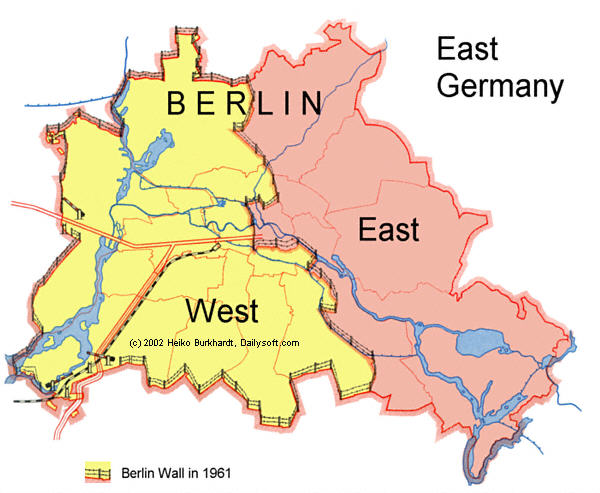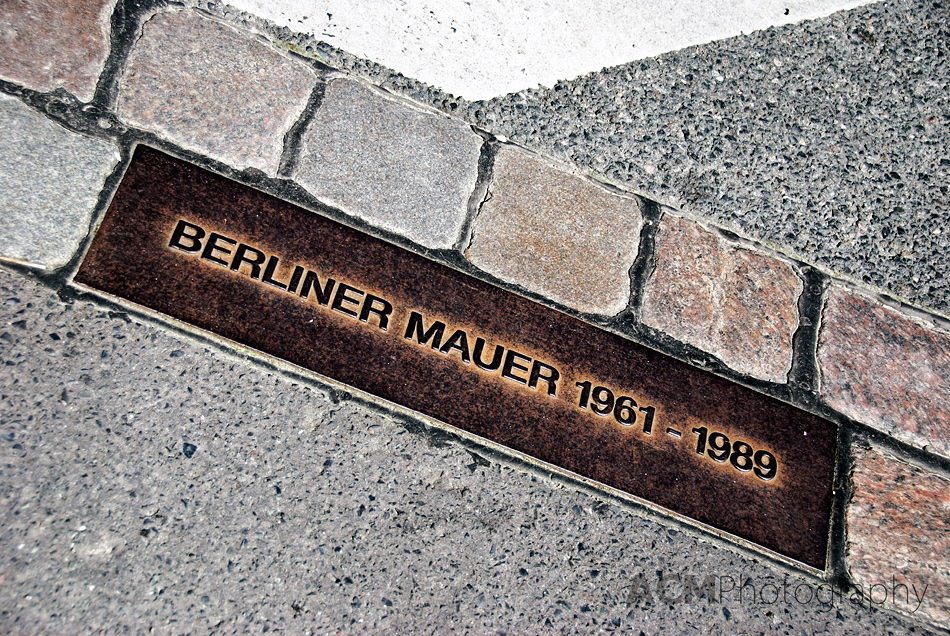Of course one can't go to Berlin without seeing parts of the 155 km Berlin Wall which separated East Berlin from West Berlin after WWII. After the war, Berlin was occupied by the victors (the USA, France, Britian and the Soviet Union). These four countries intended to rebuild and eventually reunite Germany. However, as relations between the Soviets and the others disintegrated, the cooperative atmosphere in rebuilding Germany turned competitive: East vs West, democracy vs. communism.
Britain, France and the USA combined their zones for form West Germany. The Soviet Union formed East Germany. Since Berlin was solely on the Soviet side of occupation, West Berlin became an island of democracy within Communist East Germany.


Quickly, the living conditions in East Germany and West Germany became very different. West Germany (Britain, France, USA) set up a capitalist society and experienced rapid growth. The Soviets viewed East Germany as their winnings from the war and began to pilfer factory equipment and other valuables to be shipped back to the Soviet Union. a Communist society was established in East Germany where the Soviets had complete control. As a result, the economy dragged and individual freedoms of the people were restricted.
By the late 1950's many people in East Germany wanted out. They began to pack their bags and headed to West Berlin. Once in West Berlin, they would be housed and then moved to other areas of West Germany. Although some would be stopped, hundreds of thousands made it across the border. Many of those who escaped were young, trained professionals. By the early 1961 East Germany had lost 2.5 million people.
East Germany desperately needed to stop this mass exodus. First, the Soviets attempted to overtake West Berlin in order to stop East German people from seeking refuge there. The West was committed to defending West Berlin and prevented the takeover from happening. Desperate to keep its citizens, East Germany decided to build a wall to prevent them from crossing the border.
Just past midnight on August 12-13, 1961, trucks with soldiers and construction workers rumbled through East Berlin. Roads that entered West Berlin were torn up, concrete posts were erected and barbed wire was hung across the border between East and West Berlin.

The next day, Berliners were shocked. No longer could East Berliners cross the border for operas, plays, soccer games or visiting with family and friends.

The Berlin Wall stretched over a hundred miles, cutting West Berlin off from the rest of East Germany.

Over time, improvements to the Wall were made and it was eventually constructed with concrete slabs reaching nearly 12-feet high. A 300-foot No-Man's Land, an additional inner wall, patrolling soldiers, guard dogs, trenches, electric fences, night-patrol light system, watchtowers, bunkers and minefields were also added.
 |
Legend:
|
There were a few official openings along the Wall, called checkpoints. They were infrequently used by officials and others with special permission to cross the border.
The most famous of these was Checkpoint Charlie, This was the main access point for Allied personnel and Westerners to cross the border.


The Berlin Wall did prevent the majority of East Germans from emigrating to the West. However, as the Wall became more advanced, escape attempts became more complex and daring. Tunnels were dug under the Wall, air balloons were constructed to fly over the Wall. Many escapes were not successful. Anyone found near the Wall was shot without warning.


One of the most infamous cases of a failed attempt occurred on August 17, 1962. In the early afternoon, two 18-year-old men ran toward the Wall with the intention of scaling it. The first of the young men to reach the Wall successfully scaled it. The second one, Peter Fechter, was not so lucky. As he was about the scale the Wall, a border guard opened fire. he tumbled back onto the East German side. To the shock of the world, Peter was just left there. The East German guards did not shoot him again nor did they go to his aid. Peter shouted in agony for nearly an hour. Once he finally bled to death, East German guards carried off his body.


Over time, the Communist bloc began to weaken and East Germans became increasingly unsatisfied. Communism began to falter in other countries including Poland, and Hungary during the 1980's. This allowed East Germans new exit points to flee East Germany. Then suddenly, on November 9, 1989, an announcement was made stating that "permanent relocation's can be done through all border checkpoints between East Germany into West Germany or West Berlin". People tentatively approached the border to find that border guards were letting people cross. Very quickly, the Wall was inundated with people from both sides. People began to chip away the wall with hammers and chisels. An impromptu celebration began, families and friends being reunited.

Over time, most of the Wall was torn down. A brick path has been laid where the Wall used to stand. East and West Germany were reunified into a single Germany on October 3, 1990.

No comments:
Post a Comment